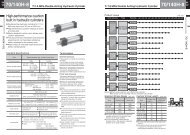70/140H-8 Series (2310KB) - TAIYO
70/140H-8 Series (2310KB) - TAIYO
70/140H-8 Series (2310KB) - TAIYO
Create successful ePaper yourself
Turn your PDF publications into a flip-book with our unique Google optimized e-Paper software.
35<br />
Precautions for use<br />
Precautions<br />
for use<br />
Use cylinders only under the operating conditions within<br />
the allowable range specified for each series. Otherwise,<br />
the performance may become unreliable as<br />
described below, or accidents may occur.<br />
1. Pressure<br />
The pressure supplied to cylinders, including surge pressure,<br />
must be lower than the maximum allowable level.<br />
The use with the pressure exceeding the maximum<br />
allowable level may lead to galling in the slipping part or<br />
the damaged cylinder.<br />
2. Speed<br />
Use cylinders within the allowable working speed range.<br />
Otherwise, troubles below may occur.<br />
When cylinders are used with the speed slower than<br />
the lower limit of the working speed range:<br />
● Stick slip (cracks)<br />
● Unsmooth speed control<br />
When cylinders are used with the speed faster than the<br />
upper limit of the working speed range:<br />
● Damaged cylinder due to increased kinetic energy<br />
● Damaged packings due to slipping heat<br />
● Increased internal or external oil leak due to<br />
thickened oil film<br />
● Higher flow velocity in the piping part, causing the<br />
lowered energy efficiency due to increased pressure<br />
loss<br />
3. Environmental conditions<br />
3-1) Temperature<br />
Use cylinders only within the allowable working temperature<br />
range. Otherwise, troubles below may occur.<br />
When cylinders are used at the temperature lower than<br />
the lower limit of the working temperature range:<br />
● Brittle fracture due to lowered stretch of cylinder<br />
material<br />
● Oil leak due to lowered elasticity of packings<br />
When cylinders are used at the temperature higher than<br />
the upper limit of the working temperature range:<br />
● Damage due to lowered strength of cylinder<br />
material<br />
● Damaged packings<br />
● Galling due to thermal expansion in the slipping part<br />
Prior to the use of cylinders, be sure to read<br />
carefully the precautions below.<br />
For the use of the items below, use them at the<br />
temperature lower than the upper limits shown below.<br />
Switch set cylinder<br />
Cylinder with position<br />
detector<br />
Items<br />
WR • WS types<br />
Other switches<br />
Cylinder with primary components for which<br />
aluminum alloy is used<br />
(35S-1 • 100S(W)-1 • 35SY-1)<br />
35P-3<br />
<strong>70</strong>/140P-8<br />
<strong>70</strong> • 140MT-3<br />
60°C or lower<br />
<strong>70</strong>°C or lower<br />
50°C or lower<br />
65°C or lower<br />
<strong>70</strong>°C or lower<br />
If several items with different upper limits of oil temperature<br />
are used, adopt the lowest temperature limit, and<br />
use the items at the temperature lower than the adopted<br />
upper limit.<br />
Ex.) When using 100SW-1R with the WR type switch,<br />
use it at 60°C or lower.<br />
3-2) Rust-proof measures<br />
The use and storage of cylinders in the places where<br />
are highly humid, or are splashed with water or sea water<br />
require the consideration of rust-proof and anticorrosion<br />
measures. In such a case, contact us.<br />
3-3) Installing location<br />
(1) Use cylinders only indoors.<br />
(2) Avoid the use in the places where are subjected to<br />
dusts and vibrations.<br />
DO NOT use them under the environmental conditions<br />
shown below. The use under these conditions requires<br />
the protection of the rod part, rust-proof measures,<br />
review of part material, magnetic shield, and vibrationproof<br />
measures. If any countermeasure required for<br />
the cylinder side, contact us.<br />
Working environmental conditions<br />
Sands, dusts, soil, chips, welder spatter, etc.<br />
Rain, water, sea water, oil, chemicals, etc.<br />
Direct sunlight (ozone), humidity, etc.<br />
High temperature, low temperature, freezing, etc.<br />
Highly magnetic field<br />
Vibrations<br />
Upper<br />
limit oil<br />
temperature




